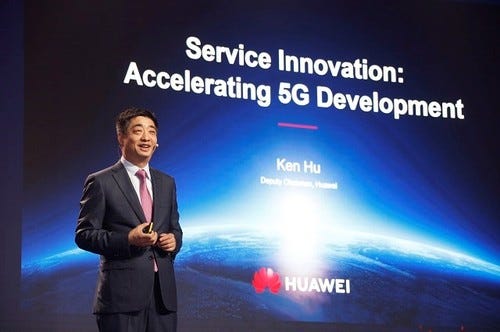Service Innovation: Accelerating 5G Development
July 1, 2019

By Ken Hu, Deputy Chairman, Huawei
At MWC Shanghai 2019, Huawei Deputy Chair Ken Hu gave an update on Huawei’s progress in 5G deployment, sharing concrete examples of how service innovation and cross-industry collaboration are driving the next phase of growth in 5G.
“The networks themselves are the foundation of everything, but the future of 5G development will rely heavily on services. 5G-enabled service innovation will help us push network performance to the next level, and help operators get greater returns on their 5G investment.”

Huawei Deputy Chairman Ken Hu speaks at MWC Shanghai 2019.
Below is a transcript of his speech:
Before I begin, I’d like to share some of our progress in 5G rollout. To date, we have signed 50 commercial contracts for 5G around the world, and we have shipped 150,000 5G base stations. This is far more than our industry peers. Many operators around the world, including those from Europe, the Middle East, and Asia Pacific, are racing to deploy their 5G networks.
Congratulations are in order for China, which officially issued its 5G licenses earlier this month. This marks the beginning of 5G commercialization in the world’s largest mobile communications market. I believe China will help set a great example for the rest of the world, and provide useful insight for deployment in other regions.
Innovation is a marathon
Why are so many operators willing to choose Huawei for 5G? I think one of the biggest reasons is our long term investment.
We often say innovation is a marathon. You need to be fast, of course, but in it for the long run. There are three unique things about Huawei’s investment in 5G innovation.
First, we invested early. We started 5G research as early as 2009. That’s back when 4G was just starting to see commercial deployment. Second, we invested heavily, and continue to do so. Over the past ten years, we have invested $4 billion dollars in 5G.
Third, we invest deeply. That’s what sets us apart from our competitors. When we began 5G research, there were no standards to speak of. We had to basically start from scratch – we couldn’t jump into product development right away. Products are only the results you see at the tail end of a very long process. So in the beginning we focused on standards development and basic research in chips, materials and algorithms.
This ongoing investment in R&D has helped us stay ahead. We hold more than 2,500 standard essential patents for 5G, which is roughly 20% of all 5G patents in the world. During the third phase of 5G field trials organized by IMT-2020, our solutions outperformed our competitors, ranking No.1 across many key indicators.
But innovation isn’t just about technology. Part of our success is our focus on making 5G easier to operate, more affordable, and simpler to deploy.
Our 5G base stations outperform our 4G base stations by a factor of 20. And they are lighter and smaller on top of that. This significantly reduces deployment costs for our customers. Now, all you need is two people, and they can install a Huawei 5G base station in only 2 hours. That’s half the time it takes for 4G.
Making 5G a commercial success
5G is already seeing large-scale deployment. As we look to the future of 5G development, what should our priorities be?
The networks themselves are the foundation of everything, of course, but the future of 5G development will rely heavily on services. 5G-enabled service innovation will help us push network performance to the next level, and help operators get greater returns on their 5G investment.
Video is a good example. With 4G, video apps like TikTok have become extremely popular, generating tons of data traffic and providing operators with new revenue streams.
As we move into the 5G era, we’ll see a much wider range of applications. 4G video applications on-demand video, whereas we’ll see much more interaction and immersion with 5G.
5G for more imaginative broadcasting
5G will change the world. We’ll see the greatest value in vertical industries.
Take the media industry, where live broadcasting is an important source of revenue. Right now, live broadcasts are mainly done over microwave or satellite, and you often see massive broadcast trucks onsite to support these capabilities. These trucks are very expensive – about 50~80 million RMB for one – and you have to prepare them several days in advance.
5G will change that. This is a 5G backpack – and in it, a 5G CPE. It is light and small, and can be placed anywhere you need it, like the roof of a car or a desk. This CPE costs less than 20,000 RMB, and it’s already changing the world of live broadcasting.
It’s completely plug-and-play. There’s no setup time, so you can throw it in a bag and set up wireless cameras wherever you need them. This CPE was used to support a live broadcast of this year’s dragon boat race in China. In the past, studios had to deploy an expensive broadcast truck several days in advance. It cost tens of thousands of RMB for every hour of footage. There weren’t enough sponsors for a live broadcast, so viewers only had access to footage from a single camera, zooming in and out from a single angle. It wasn’t an ideal experience.
Now with the 5G backpack, all dragon boat races can be broadcast live and with greater versatility. Broadcasters can put cameras on every boat, getting up close and personal with a live feed for audiences around the world.
5G for more efficient power grids
We’ve also seem some successful 5G applications in the power industry, like grid protection, drone inspections, and smart metering.
Drone inspections in particular are pretty noteworthy. Inspecting power lines used to be a manual process. One person could inspect a maximum of four kilometers of power lines per day. Now with 5G-conected drones, power companies can fly drones remotely over the network, while sending live HD video back to a centralized command center. These drones can inspect 15 kilometers of power lines every day. It’s much more efficient, and safer too.
5G for safer mines
This is a rare earth mine in Inner Mongolia. Mines aren’t generally located in the best of environments – the climate is rough, and the sites can be chaotic. It’s dangerous, especially for drivers who have to haul pay dirt back and forth across the site. At this particular mine, they have 30 trucks, each of which has 4 drivers working in two different shifts.
This presents some challenges for the mine operators and their workers.
The first is frequency of accidents. Even the most experienced drivers have trouble avoiding dangerous situations in this type of environment.
Second, efficiency is low. The best drivers can only travel about 10 kilometers per hour – anything faster would be unsafe.
Third, cost. Haul truck drivers in this mine make about 250,000 RMB per year – roughly 20,000 per month. This is a pretty high salary for drivers in China, and even then the mines have difficulty finding the right people. The environment is just too harsh, and many people aren’t up for it.
Today, 5G can help them solve these problems. With 5G networks and modules, we can enable driverless mining trucks. Cost-wise, this saves roughly one million RMB per year per driver. It also greatly increases efficiency, enabling the trucks to speed up from 10km/h to about 35km/h.
Most importantly, because the trucks are driverless, the drivers aren’t subjected to dangerous working conditions. In terms of costs, efficiency, and safety, 5G can provide a ton of value in the mining industry.
5G is driving digitization
5G will pay a pivotal role in the digitization of all industries. Right now China is in the process of evolving towards automated, digital, and AI-driven industrial development. And 5G arrived just in time to help.
5G can provide much greater bandwidth and lower latency than traditional wireless connections, and can also support different applications with dedicated network slices. This allows 5G to meet a wide range of industrial needs, and lays the foundation for a more fully automated, intelligent future.
At the same time, as more and more industries embrace intelligence, we will see much greater demand for technologies like cloud, AI, big data, and edge computing. With the support of 5G, these technologies will be able to support far more industrial applications than ever before – and much more efficiently, too.
5G will help unleash the true power of cloud, AI, and edge computing. It will also help these technologies become more pervasive in industrial settings. Moving forward, 5G will gradually converge with all of these technologies and further accelerate the digitization process.
Building out the 5G ecosystem
The key to 5G success lies in its ability to support the unique connectivity needs of each sector. As technology providers, we need to work across boundaries to better understand the business scenarios and needs of different industries.
To this end, in 2016 we opened our Wireless X Labs, a platform for operators and our industry partners to come together and incubate 5G applications together. Just last month we also opened the world’s first 5G Open Lab in Korea to support greater collaboration in the region.
With these cross-industry platforms we have already began working on more than 100 joint 5G projects with our partners across different verticals, including smart grids, new media, and others.
June 6th was a huge milestone. Now that China has issued its 5G licenses, 2019 is officially the year of 5G. As a Chinese company, and as a leader in 5G, we are super excited and eager to do our part. 5G is here. We will put our shoulders to the wheel and work with our partners to drive greater collaboration. Together, we can use the power of 5G to help all industries go digital.
— Ken Hu, Deputy Chairman, Huawei
Read more about:
Vendor SpotlightsYou May Also Like









_1.jpg?width=300&auto=webp&quality=80&disable=upscale)


.png?width=800&auto=webp&quality=80&disable=upscale)